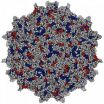(Press-News.org) In 2011, biologists at the California Institute of Technology (Caltech) demonstrated a highly effective method for delivering HIV-fighting antibodies to mice—a treatment that protected the mice from infection by a laboratory strain of HIV delivered intravenously. Now the researchers, led by Nobel Laureate David Baltimore, have shown that the same procedure is just as effective against a strain of HIV found in the real world, even when transmitted across mucosal surfaces.
The findings, which appear in the February 9 advance online publication of the journal Nature Medicine, suggest that the delivery method might be effective in preventing vaginal transmission of HIV between humans.
"The method that we developed has now been validated in the most natural possible setting in a mouse," says Baltimore, president emeritus and the Robert Andrews Millikan Professor of Biology at Caltech. "This procedure is extremely effective against a naturally transmitted strain and by an intravaginal infection route, which is a model of how HIV is transmitted in most of the infections that occur in the world."
VIDEO:
Caltech biologists David Baltimore and Alejandro Balazs discuss their novel approach to HIV prevention: a delivery method for neutralizing antibodies, which protect against HIV infection in mice.
Click here for more information.
The new delivery method—called Vectored ImmunoProphylaxis, or VIP for short—is not exactly a vaccine. Vaccines introduce substances such as antigens into the body to try to get the immune system to mount an appropriate attack—to generate antibodies that can block an infection or T cells that can attack infected cells. In the case of VIP, a small, harmless virus is injected and delivers genes to the muscle tissue, instructing it to generate specific antibodies.
The researchers emphasize that the work was done in mice and that the leap from mice to humans is large. The team is now working with the Vaccine Research Center at the National Institutes of Health to begin clinical evaluation.
INFORMATION:
The study, "Vectored immunoprophylaxis protects humanized mice from mucosal HIV transmission," was supported by the UCLA Center for AIDS Research, the National Institutes of Health, and the Caltech-UCLA Joint Center for Translational Medicine. Caltech biology researchers Alejandro B. Balazs, Yong Ouyang, Christin H. Hong, Joyce Chen, and Steven M. Nguyen also contributed to the study, as well as Dinesh S. Rao of the David Geffen School of Medicine at UCLA and Dong Sung An of the UCLA AIDS Institute.
Caltech-developed method for delivering HIV-fighting antibodies proven even more promising
2014-02-11
ELSE PRESS RELEASES FROM THIS DATE:
The content of our cooperation, not the color of our skin
2014-02-11
It's widely acknowledged that a common threat unites people. Individuals who were previously separated by social class, race or ethnicity come together, forming new cooperative alliances to defeat a common enemy. But does it take an external threat — an attack like Pearl Harbor or 9/11 — to make these social divisions melt away?
A study by behavioral scientists at UC Santa Barbara demonstrates that peaceful cooperation has the same effect as intergroup conflict in erasing social boundaries connected to race. Their findings appear today in the journal PLOS ONE.
"Evolution ...
Fish living near the equator will not thrive in the warmer oceans of the future
2014-02-11
According to an international team of researchers, the rapid pace of climate change is threatening the future presence of fish near the equator.
"Our studies found that one species of fish could not even survive in water just three degrees Celsius warmer than what it lives in now," says the lead author of the study, Dr Jodie Rummer from the ARC Centre of Excellence for Coral Reef Studies (Coral CoE) at James Cook University.
Dr Rummer and her colleagues studied six common species of fish living on coral reefs near the equator. She says many species in this region only ...
How our brain networks: Research reveals white matter 'scaffold' of human brain
2014-02-11
For the first time, neuroscientists have systematically identified the white matter "scaffold" of the human brain, the critical communications network that supports brain function.
Their work, published Feb. 11 in the open-source journal Frontiers in Human Neuroscience, has major implications for understanding brain injury and disease. By detailing the connections that have the greatest influence over all other connections, the researchers offer not only a landmark first map of core white matter pathways, but also show which connections may be most vulnerable to damage.
"We ...
Scientists identify gene linking brain structure to intelligence
2014-02-11
For the first time, scientists at King's College London have identified a gene linking the thickness of the grey matter in the brain to intelligence. The study is published today in Molecular Psychiatry and may help scientists understand biological mechanisms behind some forms of intellectual impairment.
The researchers looked at the cerebral cortex, the outermost layer of the human brain. It is known as 'grey matter' and plays a key role in memory, attention, perceptual awareness, thought, language and consciousness. Previous studies have shown that the thickness of ...
New research sheds light on how the body regulates fundamental neuro-hormone
2014-02-11
New research has revealed a previously unknown mechanism in the body which regulates a hormone that is crucial for motivation, stress responses and control of blood pressure, pain and appetite. The breakthrough could be used to design drugs to help fight health problems connected with these functions in the future.
Researchers at the University of Bristol and University College London found that lactate – essentially lactic acid – causes cells in the brain to release more noradrenaline (norepinephrine in US English), a hormone and neurotransmitter which is fundamental ...
Researchers discover 'epic' new Burgess Shale site in Canada's Kootenay National Park
2014-02-11
February 11, 2014 Kootenay National Park, British Columbia -- Yoho National Park's 505-million-year-old Burgess Shale – home to some of the planet's earliest animals, including a very primitive human relative – is one of the world's most important fossil sites. Now, more than a century after its discovery, a compelling sequel has been unearthed: 42 kilometres away in Kootenay National Park, a new Burgess Shale fossil site has been located that appears to equal the importance of the original discovery, and may one day even surpass it.
The find was made in the summer of ...
Minority political candidates just need a chance
2014-02-11
EAST LANSING, Mich. — It's not necessarily voters who should be blamed for the lack of minorities in state legislatures, but instead the two major political parties for not recruiting enough candidates, indicates new research by a Michigan State University scholar.
Eric Gonzalez Juenke analyzed nearly 10,000 statehouse elections in 2000 and 2010 and found Latino candidates were on the ballot just 5 percent of the time. But when Latinos did run for office, they won just as often as their white counterparts – even in districts where most voters were white.
Juenke's other ...
Biodiversity in production forests can be improved without large costs
2014-02-11
Forest management is based on recommendations that are supposed to maximize economic revenues. However, in 40% of cases a better economic result would be achieved by neglecting some of the recommendations. This would also greatly benefit biodiversity.
These results were obtained by a research group lead by Professor Mikko Mönkkönen at the University Jyväskylä. The group studied a production forest landscape encompassing 68 square kilometers of land and more than 30,000 forest stands in Central Finland.
The research project aimed at revealing the potential of a forest ...
Even moderate weight loss can prevent and cure obstructive sleep apnoea
2014-02-11
Even a moderate weight reduction can prevent the progression of obstructive sleep apnoea (OSA), and even cure it, according to a 4-year Finish follow-up study published recently in Sleep Medicine. The study focused on the effects of weight loss on OSA and demonstrated, for the first time, that a sustained weight loss of just 5% was enough to prevent the disease from worsening and even cure it in a long-term follow-up.
Obstructive sleep apnoea (OSA) has become a major burden for our health care systems over the last years. Although it is one of the most increasingly prevalent ...
Photo + fragrance of chocolate cake = more chocolate cakes sold
2014-02-11
Fashion magazines come pre-loaded with scratch-and-sniff panels for perfume and aftershave, but what about advertisements for foods like chocolate chip cookies and fresh-baked bread? According to a new study in the Journal of Consumer Research, when food advertisements combine a photo of food with an "imagined odor," consumers both salivate more for the item and then consume it in larger quantities.
"We wondered whether both real and imagined food smells would enhance consumer desire for that product. Does the concept of smelling food make people salivate more and increase ...




